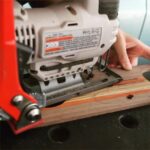Are you wondering how to make a woodworking shop apron? Woodworking shop aprons have been an essential garment for woodworkers for centuries. They serve as a protective barrier, keeping sawdust and debris off your clothes while providing convenient storage for tools and supplies. In this article, we will guide you through the process of creating your own durable and functional woodworking shop apron, from choosing the right materials to adding personalized touches and maintaining it for long-lasting use.
When working on woodworking projects, having the right attire is crucial. A well-made woodworking shop apron not only protects your clothing but also provides easy access to tools and supplies, making it an indispensable addition to any woodworker’s arsenal. By following our step-by-step instructions and tips, you can create a custom apron that suits your needs and reflects your personal style.
In the following sections, we will delve into the details of choosing the right materials and tools for your project, taking accurate measurements, sewing pockets and straps, adding embellishments and customization, ensuring durability with proper finishing and reinforcements, as well as caring for your apron to keep it in top condition. Additionally, we will provide practical advice on utilizing your woodworking shop apron effectively in a workshop environment.
So, let’s get started on creating the perfect woodworking shop apron tailored just for you.
Choosing the Right Materials and Tools
When it comes to making a woodworking shop apron, choosing the right materials and tools is crucial to ensuring the durability and functionality of the finished product. The first step in this process is selecting the appropriate fabric for the apron.
Heavy-duty fabrics such as denim, canvas, or waxed cotton are popular choices due to their sturdiness and ability to withstand wear and tear in a workshop environment. Additionally, these fabrics offer some level of protection against small wood chips and flying debris.
In addition to the fabric, you will also need to gather some essential tools for this project. These may include a sewing machine, thread in a coordinating color, fabric scissors, pins or clips for securing the fabric while sewing, and measuring tape. It’s important to have quality tools on hand to ensure that your woodworking shop apron turns out well-made and long-lasting.
Best Fabrics for Woodworking Shop Aprons
When considering the best fabrics for a woodworking shop apron, it’s important to prioritize durability and comfort. Denim is a popular choice due to its ruggedness, while canvas provides excellent strength and resistance to abrasion. Waxed cotton offers water-resistant properties, providing an additional layer of protection against potential spills or splashes in the workshop setting.
Essential Tools Needed for the Project
Having the right tools for making a woodworking shop apron can make all the difference in the final product. A heavy-duty sewing machine capable of handling thick fabrics is crucial for creating sturdy seams. Quality fabric scissors are essential for precise cutting, while pins or clips will help secure pieces together during sewing. Lastly, a measuring tape is necessary for taking accurate measurements before cutting your chosen fabric.
When working on making a woodworking shop apron, it’s vital to choose high-quality materials and invest in reliable tools that will result in a durable and functional garment suitable for use in a workshop environment.
Taking Measurements and Cutting the Fabric
When making a woodworking shop apron, one of the crucial steps is taking accurate measurements and cutting the fabric to the right size. This ensures that the apron will fit well and provide the necessary protection while working on woodworking projects. Here’s a step-by-step guide on how to take measurements and cut the fabric for your woodworking shop apron:
1. Measure Your Body: Use a flexible tape measure to determine the width of your chest, waist, and hips. These measurements will help you create an apron that fits comfortably and allows for movement while working in the workshop.
2. Length of Apron: Decide how long you want your apron to be – whether it’s hip-length, knee-length, or longer. Measure from your chest or waist down to your desired length to determine how much fabric you will need.
3. Width of Apron: Depending on how much coverage you want, measure across your body to determine the width of the apron. This will ensure that the apron adequately covers your front and sides while working.
4. Cutting the Fabric: Once you have all your measurements, lay out the fabric on a flat surface and use fabric shears to cut out the main body of the apron according to your measurements.
By carefully taking these measurements and cutting the fabric accurately, you can ensure that your woodworking shop apron fits well and provides excellent protection during woodworking activities.
Remember that precision is key when taking these measurements, as any errors could result in an ill-fitting apron that may not offer adequate coverage or comfort during use.
Sewing the Pockets and Straps
When it comes to making a woodworking shop apron, sewing the pockets and straps is a crucial step in ensuring functionality and practicality. The pockets are essential for holding tools, pencils, and other small items needed during woodworking projects. Additionally, comfortable and adjustable straps are necessary for providing a secure fit while working in the shop. Here’s a step-by-step guide on how to sew the pockets and straps for your woodworking shop apron:
- Begin by determining the placement and size of the pockets on the apron. Consider what tools and accessories you will need to carry in the pockets and create a design that suits your specific needs.
- Using durable fabric such as canvas or denim, cut out pieces for the pockets according to your measurements. Remember to leave seam allowances when cutting the fabric.
- Sew the pocket pieces together, leaving one side open for easy access. Reinforce the seams to ensure that the pockets can withstand the weight of tools and other items.
In addition to sewing the pockets, attaching comfortable and adjustable straps is essential for ensuring a proper fit for your woodworking shop apron. Here’s how to sew the straps:
- Cut out fabric strips for the straps according to your measurements, ensuring that they are long enough to provide a secure fit around your waist.
- Sew the ends of each strap securely onto the top corners of the apron, ensuring that they are evenly spaced and placed at an appropriate height for comfort.
- Add adjustable features such as D-rings or buckles to allow for easy adjustment of the apron’s fit.
By following these steps, you can ensure that your woodworking shop apron is not only functional but also comfortable to wear during long hours in the workshop. These details may seem small, but they make a significant difference in how convenient it is to use your apron while working on various woodworking projects.
Remember that when making an apron, attention should be paid not only on how it looks but also on its functionality so it can serve its purpose well in keeping you organized during woodworking tasks.
Embellishments and Customization
Once you have the basic structure of your woodworking shop apron completed, it’s time to add some personal flair and customization to make it truly your own. Adding personalized touches to your apron not only showcases your individual style but can also serve as a form of branding for your woodworking projects.
One popular way to customize a woodworking shop apron is by adding embroidery or patches. You can personalize the apron with your name, initials, or even a logo that represents your woodworking brand. Embroidery can be done by hand for a more artisanal touch, or by machine for a more polished look. Patches are also a great option, as they can easily be attached and removed if you want to change up the design in the future.
In addition to embroidery and patches, there are other ways to embellish your woodworking shop apron. Consider adding decorative stitching along the edges or pockets, using contrasting fabric for trim, or incorporating leather accents for a more rustic look. The options for customization are endless, so take this opportunity to get creative and make your apron truly unique.
By adding these personal touches and customization to your woodworking shop apron, you not only create a functional piece of workwear but also an expression of your own creativity and individuality. The finished apron will not only protect you from sawdust and stains but will also showcase your passion for woodworking every time you wear it in the workshop.
Whether you want to embroider your name on the front pocket or add patches that represent different aspects of your craft, embellishing and customizing your woodworking shop apron is an enjoyable way to make the garment uniquely yours. So gather those embroidery threads, select some fun patches, and let your creativity run wild as you put the final touches on this essential workshop accessory.
Finishing and Reinforcements
When it comes to creating a durable and functional woodworking shop apron, paying attention to the finishing details and reinforcements is crucial. These elements not only ensure that the apron lasts for a long time but also provides the necessary support and strength during woodworking projects. In this section, we will delve into the key aspects of finishing and reinforcements for your handmade woodworking shop apron.
Sturdy Seams and Stitching
One of the most important aspects of finishing a woodworking shop apron is ensuring that the seams are sturdy and well-stitched. Double stitching or using a reinforced stitch pattern can significantly increase the longevity of the apron, especially in high-stress areas such as pockets or straps. Be sure to use a strong thread that can withstand wear and tear, and consider adding seam tape or binding for extra reinforcement.
Additional Reinforcements
In addition to sturdy seams, adding extra reinforcements to specific areas of the apron can further enhance its durability. Consider using grommets or rivets in areas where straps attach to the main body of the apron, as these metal reinforcements can prevent tearing and stretching over time. For pocket corners or other high-use areas, adding patches or extra layers of fabric can provide added strength and protection against wear.
Final Touches
Once all the sewing and reinforcement work is completed, it’s essential to give your woodworking shop apron some final touches. Trim any loose threads, press any seams if necessary, and inspect the entire apron for any missed stitches or weak spots. Taking these extra steps ensures that your apron is not only durable but also looks professional and well-finished.
By paying close attention to finishing details and reinforcements in your woodworking shop apron project, you can create a reliable garment that will serve you well in your workshop for years to come.
Caring for Your Woodworking Shop Apron
Once you have taken the time and effort to craft your own woodworking shop apron, it’s important to ensure that it stays in top condition for as long as possible. Caring for your apron not only preserves its functionality but also maintains its aesthetic appeal. Here are some essential tips on how to properly care for and maintain your woodworking shop apron.
Proper maintenance begins with regular cleaning of the apron. Depending on the level of use and exposure to dust, dirt, or stains, it’s advisable to clean the apron after each use or at least once a week. For regular maintenance, a simple hand wash with mild detergent should suffice. However, if the apron is heavily soiled or stained, consider machine washing it on a gentle cycle.
When storing your woodworking shop apron, make sure it is kept in a clean and dry area. Hanging the apron when not in use can help prevent creases and wrinkles while allowing air circulation to keep it fresh. Avoid storing the aprons in damp or humid conditions as this can cause mold and mildew to develop on the fabric.
| Caring Tip | Description |
|---|---|
| Cleaning | Regular hand washing with mild detergent; machine wash on gentle cycle if heavily soiled |
| Storage | Hang in clean, dry area; avoid damp or humid conditions to prevent mold and mildew |
Another important aspect of caring for your woodworking shop apron is addressing any damage promptly. If you notice any tears, loose threads, or worn-out areas, make repairs immediately to prevent further deterioration. Simple sewing repairs can be done at home with basic sewing supplies and skills. Additionally, adding reinforcing stitches over high-stress areas such as pockets and straps will prolong the lifespan of the apron.
Tips for Using Your Woodworking Shop Apron
When it comes to using your woodworking shop apron, there are a few tips and tricks that can help you maximize its functionality and convenience in the workshop. A durable and well-made apron not only protects your clothing from sawdust, wood shavings, and other debris, but it can also keep essential tools and supplies within arm’s reach as you work on your projects.
Here are some practical tips for making the most of your woodworking shop apron:
First, consider the layout of pockets and compartments on your apron to optimize organization. Having various sizes of pockets can accommodate different tools and accessories, making them easily accessible while you work. For instance, smaller pockets are ideal for holding nails, screws, or pencils, while larger pockets can store larger hand tools or safety glasses.
Another useful tip is to regularly clean and inspect your apron to ensure it stays in good condition. Depending on the materials used in its construction, your apron may be machine washable or require hand washing. Additionally, check for any loose stitching or signs of wear that may need reinforcement or repair.
Lastly, always remember to adjust the straps of your apron for a comfortable fit. Properly adjusted straps will distribute the weight of the apron evenly across your shoulders and back, reducing strain during extended periods of wear.
| Usage Tips | Description |
|---|---|
| Optimize Pocket Layout | Arrange different pocket sizes strategically to accommodate various tools and accessories. |
| Maintain Cleanliness | Regularly clean and inspect the apron to ensure it remains in good condition. |
| Comfortable Fit | Adjust the straps for a comfortable fit that distributes weight evenly. |
Conclusion
In conclusion, making your own woodworking shop apron can be a satisfying and practical project for anyone passionate about woodworking. By selecting the right materials and tools, taking accurate measurements, sewing pockets and straps, adding personal touches, and reinforcing the seams, you can create a durable and functional apron that meets your specific needs in the workshop. Additionally, by following proper maintenance tips and using the apron effectively during woodworking projects, you can prolong its lifespan and maximize its convenience.
It is crucial to remember that a woodworking shop apron not only serves as protection for your clothing but also keeps essential tools and supplies within arm’s reach while working on projects. Whether you are a seasoned woodworker or just starting out in the craft, having a well-made apron can greatly enhance your workshop experience.
We encourage everyone to embark on their own woodworking shop apron project, explore creativity when customizing their apron, and share their experiences with others in the woodworking community.
Ultimately, making a woodworking shop apron is an opportunity to showcase your individual style while ensuring practicality and functionality in the workshop. So gather your materials, follow the steps outlined in this guide on how to make a woodworking shop apron, and enjoy the process of creating something that is both useful and uniquely yours.
Frequently Asked Questions
What Are Workshop Aprons Made Of?
Workshop aprons are typically made of durable and easy-to-clean materials such as canvas, denim, or leather. These fabrics provide protection from dirt, grease, and sharp objects while being comfortable to wear for long periods.
How Do You Make an Apron for Work?
To make an apron for work, you’ll need to choose a suitable fabric, measure and cut the material according to a pattern or your own measurements, then sew the pieces together to form the apron shape. Finally, add any necessary pockets or straps for wearing.
How Many Yards Does It Take to Make an Apron?
The amount of fabric needed to make an apron can vary depending on the size and style of the apron. On average, it takes about 1 to 1.5 yards of fabric to create a standard-sized apron with no frills or extra features.
However, if you’re making a full-coverage or specialty apron, you may need more fabric to accommodate these designs.

Hi everyone! I’m a woodworker and blogger, and this is my woodworking blog. In my blog, I share tips and tricks for woodworkers of all skill levels, as well as project ideas that you can try yourself.





